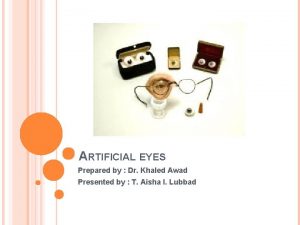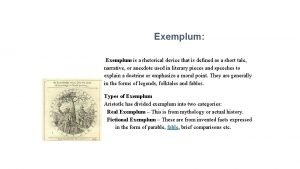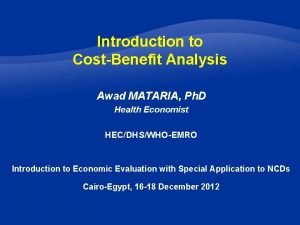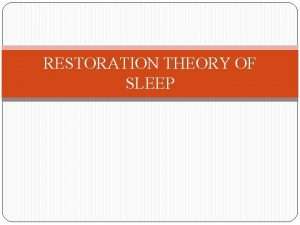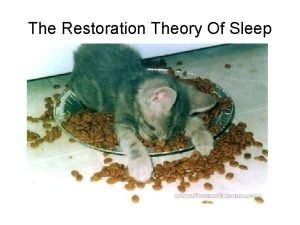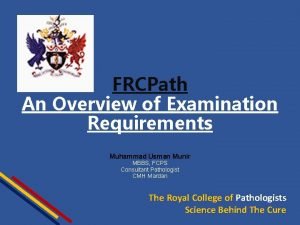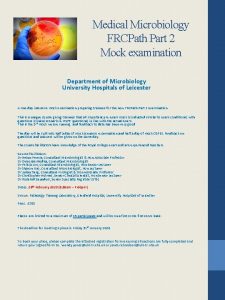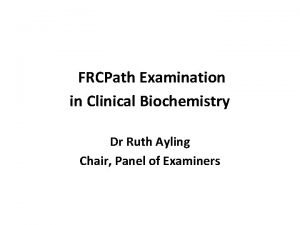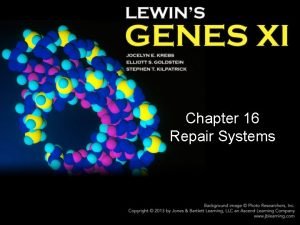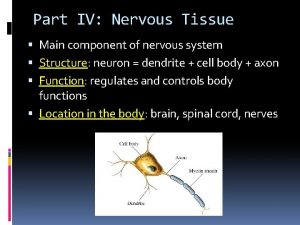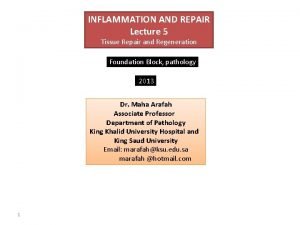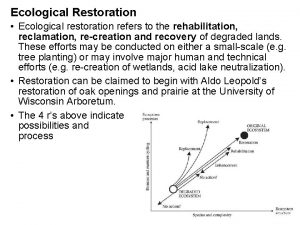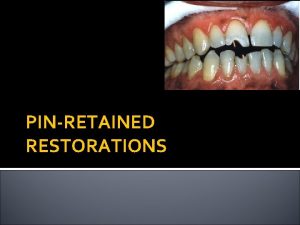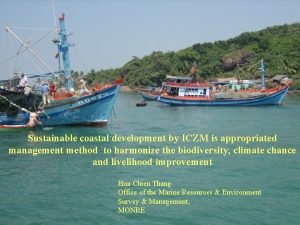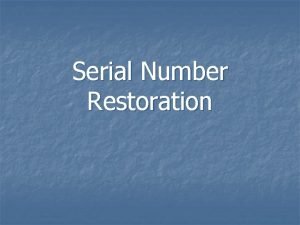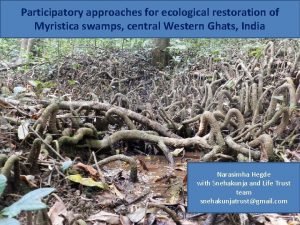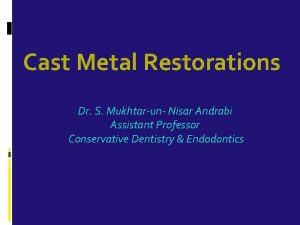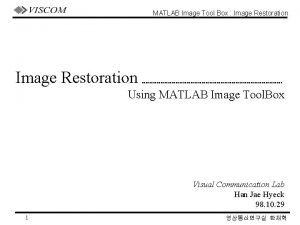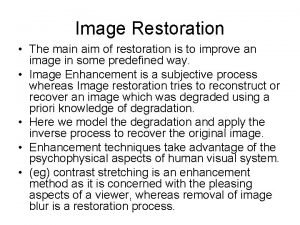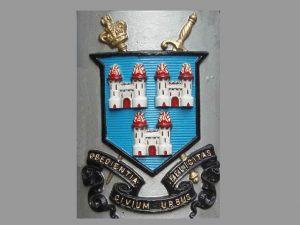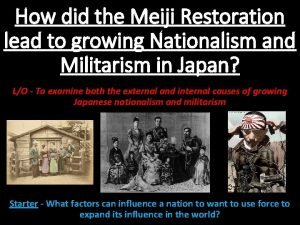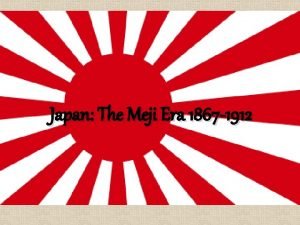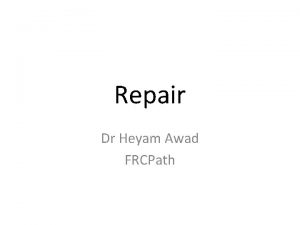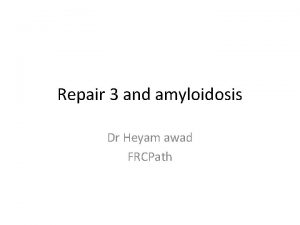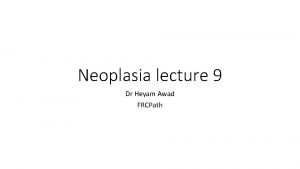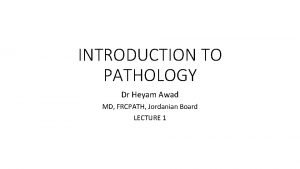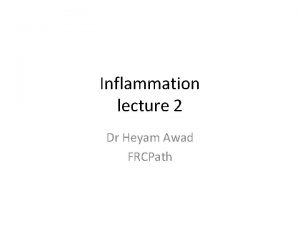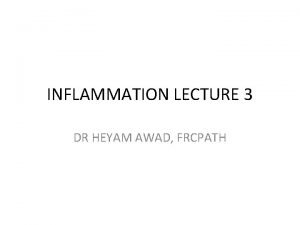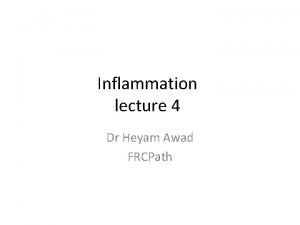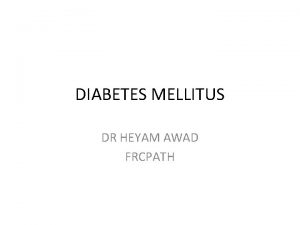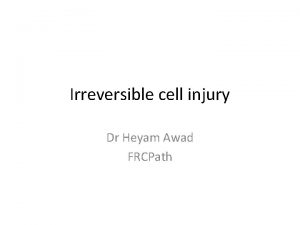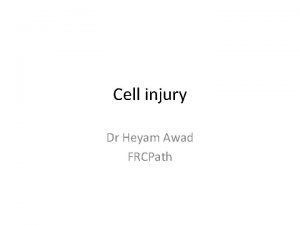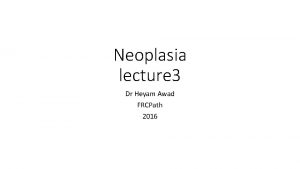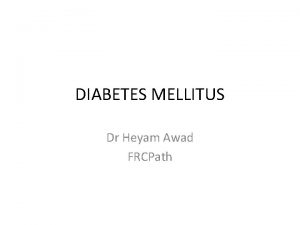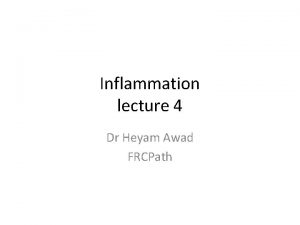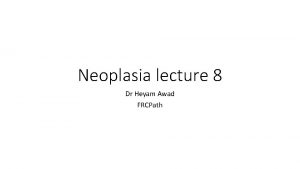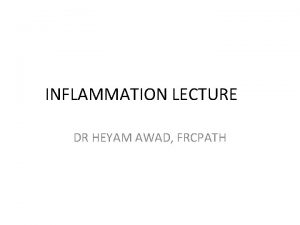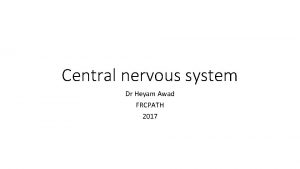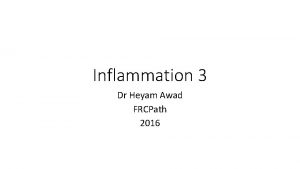Repair Dr Heyam Awad FRCPath Tissue repair Restoration










































- Slides: 42

Repair Dr Heyam Awad FRCPath

Tissue repair • Restoration of tissue architecture and function after injury. Two types : • 1) regeneration. • 2) scar formation.

Regeneration • Replacement of damaged cells and restoration of normal function. • Happens by proliferation of residual, uninjured cells that can replicate and by tissue replacement from stem cells.

Scar formation • = repair by fibrous tissue, resulting in a scar. • Happens if the injured tissue unable to replicate or the supportive structures of the tissue are severely injured. • The scar cannot perform the lost function but it gives structural support.

• In many situation … both, regeneration and scar formation contribute to repair.

Cell and tissue regeneration Cells that replicate during repair: • 1. Remnant of injured tissue. • 2. Endothelial cells. • 3. Fibroblasts. • The proliferation of all these cells is controlled by growth factors.

Normal size of cell population is controlled by a balance between: • Cell proliferation • Cell death by apoptosis • Formation of new differentiated cells from stem cells.

Cell cycle

Cell cycle • Non dividing cells are arrested in G 1 phase or exited the cell cycle at G 0 phase. • Growth factors. . Stimulate transition from G 0 to G 1 and beyond into S phase, G 2 and M phase. • This progression is regulated by cyclins that are regulated by cyclin dependent kinases.

Proliferation capacities of tissues • Labile cells • Stable cells • Permeant cells

Labile tissue • Labile tissue= continuously dividing tissue. continously lost and replaced by proliferation of mature cells and by maturation from stem cells. • Examples: Hematopietic cells, skin and surface epithelium

Stable tissue • • Quiescent , inactive cells Minimal replicative activity in the normal state. Can proliferate in response to injury Examples: Parenchyma of solid organs, Endothelial cells, Fibroblasts, Smooth muscle cells. • Stable tissue , except the liver, has limited capacity to regenerate.

Permanent tissue • Permanent tissue: terminally differentiated and non proliferative. • Neurons and cardiac muscle • Limited stem cell replication and differentiation occur in some areas of the adult brain • Cardiac stem cells may proliferate. • Skeletal muscle usually classified as permanent but stellate cells provide some regeneration.

Stem cells • Self renewal capacity • Asymmetric replication

Asymmetric replication


Stem cells • 1. embryonic stem cells. • 2. adult stem cells.

Embryonic stem cells • Undifferentiated. • Extensive cell renewal capacity. • Can differentiate to the three germ cell layers.

Adult stem cells • Less undifferentiated. • Their lineage potential restricted to the differentiated cells in the organ they are found in. • Important in maintaining tissue size and in repair.

Tissue (adult) stem cell use in medicine Restricted by: 1. Difficulty in isolating them to purity 2. They are present in stem cell niches… without which they cannot function properly.

Stem cell niches • microenvironment, within the specific anatomic location where stem cells are found, which interacts with stem cells to regulate cell fate.

Stem cell niches

Tissue stem cells uses • Treatment of certain diseases…. Leukaemia and lymphoma…. . By hematopoietic stem cells. • Regenerative medicine… to regenerate damaged tissues……… difficult because of the problems mentioned previously!

Embryonic stem cells uses • Regenerative medicine. . • Problem: immunologic rejection. • Solution: tried to generate stem cells from patients’ own cells = i. PS.

i. PS • = induced pleuripotent stem cells. • How? By identifying certain genes needed for stem-cell-ness • These genes are introduced in differentiated cells… this causes reprogramming of somatic cell nucleus. . It acquires properties of embryonic stem cells. • Clinical usefulness? ? ?

i. PS


Growth factors • Proteins that stimulate cell survival and proliferation. • They can also promote migration, differentiation and other cellular responses. • derived from macrophages, endothelial cells, mesenchymal and many other cells.

GFs • • EPIDERMAL GROWTH FACTOR TGF ALPHA TGF BETA HEPATOCYTE GF PDGF KERATINOCYTE GF VEGF

GF • • • GF stimulate cell growth by: 1. promote entry to cell cycle. 2. releive blocks on cell cycle progression. 3. Prevent apoptosis. 4. increase protein synthesis

Signalling mechanisms of GFs • GFs function through receptors…. And trigger biochemical signals … which stimulate or repress gene expression

GF signalling • Can be • Autocrine. . On the same cell that produced the factor • Paracrine… between adjacent cells • Endocrine. . Through blood.


GF receptors • Receptors with intrinsic kinase activity. • G protein coupled receptors • Receptors without intrinsic enzymatic activity.

Receptors with intrinsic kinase activity • Ligand binds to receptor… dimerization and phosphorylation of the receptor subunits…. • Phosphorylated receptor… bind activate intracellular proteins …. cell proliferation.


G coupled proteins • Seven transmembrane alpha helices, coupled with G protein (GTP binding protein). • Ligand binding: GDP in the G protein changes to GTP… receptor activated. • Signal transduction through second messengers including c. AMP.


G protein- coupled receptors

Receptors without intrinsic enzymatic activity • Ligand. . Conformational change of receptor intracellular domain…. So it can bind to intracytoplasmic kinase (Janus kinases = JAKs). • Now receptor activated… stimulation of STATs (signal transducers and activators of transcription)…. goes to nucleus… induces transcription


 Khaled awad md
Khaled awad md Exemplum literary definition
Exemplum literary definition Awad mataria
Awad mataria Repair theory of sleep
Repair theory of sleep Repair and restoration theory of sleep
Repair and restoration theory of sleep Repair renovation and restoration of water bodies
Repair renovation and restoration of water bodies Mydetas
Mydetas Frcpath part 1 microbiology
Frcpath part 1 microbiology Frcpath clinical biochemistry
Frcpath clinical biochemistry Dna repair pathways
Dna repair pathways Base excision repair vs mismatch repair
Base excision repair vs mismatch repair Nervous tissue repair
Nervous tissue repair Healing by first intention
Healing by first intention Jaringan epitel dapat ditemukan di
Jaringan epitel dapat ditemukan di Ecological restoration
Ecological restoration Mississippi state port authority
Mississippi state port authority Chapter 55 ecosystems and restoration ecology
Chapter 55 ecosystems and restoration ecology Pin-retained composite restoration
Pin-retained composite restoration Slot retained amalgam restoration
Slot retained amalgam restoration Coastal protection
Coastal protection The use of acid to etch the obliterated serial number.
The use of acid to etch the obliterated serial number. Restoration movement colleges
Restoration movement colleges Ecosystem restoration in kannada
Ecosystem restoration in kannada Image restoration adalah
Image restoration adalah The restoration refers to
The restoration refers to Channelisation geography
Channelisation geography Skirt preparation in onlay
Skirt preparation in onlay Image restoration matlab
Image restoration matlab Cameraman.tif
Cameraman.tif Martello tower restoration man
Martello tower restoration man South florida ecosystem restoration task force
South florida ecosystem restoration task force Restoration colonies
Restoration colonies Restoration period notes
Restoration period notes Doctrine and covenants 110:1-10
Doctrine and covenants 110:1-10 Biocultural restoration
Biocultural restoration Meiji restoration
Meiji restoration Japan before meiji restoration
Japan before meiji restoration 7 elements of satire
7 elements of satire Meiji restoration definition
Meiji restoration definition Chapter 55 ecosystems and restoration ecology
Chapter 55 ecosystems and restoration ecology Skirt preparation in onlay
Skirt preparation in onlay National water restoration
National water restoration Emperor shogun daimyo samurai peasants
Emperor shogun daimyo samurai peasants
